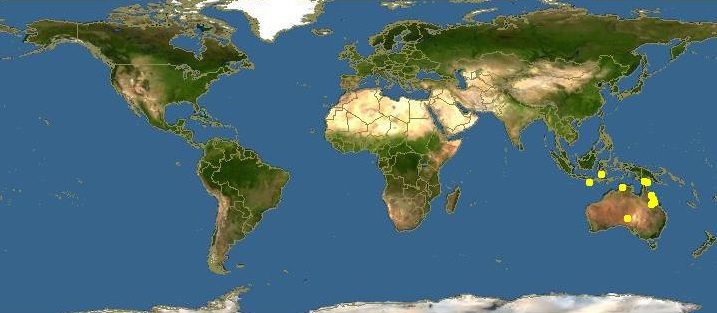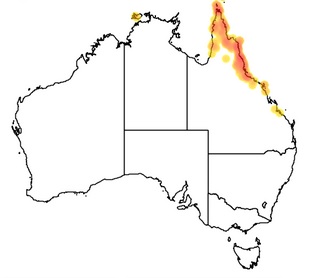Acacia crassicarpa
Contents
General Plant Info
Acacia crassicarpa, also known as "Thick-podded Salwood", are found as trees 6–25 (–30) m tall, sometimes shrubs less than 1 m tall on coastal dunes.
In its native range, the main flowering season is May – June, but light flowering may occur as late as September. The peak fruiting season is October – November; but there is considerable variation between locations and from year to year
Geographic distribution
 Acacia crassicarpa occurs in northern Queensland, the Torres Strait islands, and New Guinea. In Queensland it extends from Badu, Banks, Horn and Prince of Wales Islands in Torres Strait and Cape York Peninsula S to Townsville; southern outliers occur at the Burdekin River (south west of Ayr), Whitsunday Island and from Slade Point near Mackay.
Acacia crassicarpa occurs in northern Queensland, the Torres Strait islands, and New Guinea. In Queensland it extends from Badu, Banks, Horn and Prince of Wales Islands in Torres Strait and Cape York Peninsula S to Townsville; southern outliers occur at the Burdekin River (south west of Ayr), Whitsunday Island and from Slade Point near Mackay.
It is most common on sandy, lowland, coastal or near-coastal sites, where it is found on sandy levees near seasonally-dry creeks and on coastal foredune systems.
In New Guinea it occurs in the southern lowlands from south-eastern Irian Jaya, Indonesia, and E to the Oriomo River region of Papua New Guinea.
Identification
The trees are usually between 6 and 25 m tall, but some grow to 30 m. On coastal dunes they tend to be shrubs, sometimes less than 1 m tall. The bark is deeply cracked.
Phyllodes vary from 8 to 27 cm in length, (0.7–) 1–4.5 cm wide, and have about 7 veins more prominent than the rest. Phyllodes normally lanceolate-falcate, narrowly tapered at base above the pulvinus, glabrous, pale green to grey-green; longitudinal nerves numerous and closely parallel (not anastomosing), 4–6 per mm; pulvinus (5–) 8–16 mm long, phyllode lamina blending gradually into the pulvinus.
Pods are oblong to narrowly oblong, flat, woody, (3–) 4–12 cm long, (1–) 2–4.5 cm wide, dehiscing along ventral suture, the nerves transverse to transversely oblique, crowded and numerous. In the absence of pods A. crassicarpa may resemble specimens of Acacia meiosperma which have falcate phyllodes.
Seeds traverse, obloid to ovid, glossy black, 5–6 mm long, 3–4 mm wide, +/- terete, arranged separately in separate compartments and their arils are cream to white, ageing cream or pale yellow. Funicle/aril many-folded, 5–20 mm long (unextended), seed is produced in abundance after 4 years. The seeds mature 5–6 months after flowering.
Inflorescence are bright yellow spike, 4–7 cm long, clustered in groups of 2–6 or so in the upper axils. Peduncles 3–10 mm long, glabrous; spikes (2–) 3–7 cm long, +/- interrupted, light golden to pale yellow. Flowers 5-merous; calyx gamosepalous; ovary densely hairy on upper half. The flowers are bisexual. Flowering starts as early as 6 months after the tree is established.
Bark deeply rimose. Dead bark layered. Living bark strong and fibrous. Branchlets sometimes pendulous, glabrous.
Throughout its range A. crassicarpa is variable in habit and the size of its phyllodes and pods. For example, on Lizard Island, Qld, the type locality, growth habit appears strongly affected by wind shear: small trees with relatively short trunks and spreading canopies are characteristic. Relatively small pods (4–8 cm long; 1.3–2 cm wide) are also typical. A specimen collected from Palfry Island, Qld, has atypically narrow phyllodes (7–8 mm wide).
Alkaloid content
Other uses
This tree is a vigorous nitrogen-fixer and nodulates well. The leaves decompose slowly, and are useful as mulch. The wood from the tree dries out moderately quickly and is useful for firewood and charcoal. It also makes good wood-pulp, better from the softer wood of plantation-grown trees than from the native ones. The sapwood is pale yellowish brown and the heartwood golden brown. The wood is suitable for a wide range of sawn-timber end uses, for light construction, furniture, flooring and boat-building.
Fuel: The wood dries out moderately rapidly, burns well and is useful for firewood and charcoal, although it sparks at ignition and produces some fly ash and smoke during flaming. Its energy value is 22 600 kJ/kg. Fibre: A. crassicarpa is suitable for kraft pulping, with a moderate screened pulp yield of 47%, and excellent pulpwood productivity (300 kg per cubic metre). Fast-grown plantation wood of lower density may prove more suitable for pulp production than wood from native trees. Timber: The sapwood is pale yellowish-brown and heartwood golden-brown. The wood is strong and durable with a density of 670–710 kg/cubic metre. It is suitable for a wide range of sawn timber end-uses including light structural and decorative purposes. Examples include construction, furniture, flooring, board and boat building
Extraction
Cultivation
In recent years populations of A. crassicarpa from Papua New Guinea have shown commercial potential for use in plantations in South East Asia, particularly Indonesia and Thailand
Seeds remain viable for many years and heat treatment or nicking of the seed coat is required to break dormancy. Immersion in boiling water for 1 minute is also a suitable treatment. Treated seeds are sown in germination beds, and seedlings with 2 pairs of leaves can be transplanted into polythene bags containing a mixture of soil and river sand. They are raised under partial shade, then in the open, and planted out when stem height reaches 25–30 cm. Inoculation of nursery seedlings with a selected Rhizobium strain prior to planting out is recommended for maximum nodule development. Vegetative propagation through air-layering has given promising results in Thailand. Cuttings may be successful for trees up to 3 years old but older trees are difficult to root. Marcotting is effective for older specimens.
Under favourable conditions seedlings grow rapidly reaching 25–30 cm in 3–4 months. A. crassicarpa is one of the fastest growing tropical Acacia species. It appears to maintain active shoot growth almost the year round, although a few months of stagnation may occur in the dry season. On sites dominated by Imperata cylindrica or other weedy plants, weed control is necessary in the first 1–2 years to ensure establishment. Coppicing ability varies with cutting height and provenance, but is not a suitable method of regeneration, since trees do not coppice well. In open situations, the crown is strongly branched and casts a moderate shade. Preliminary observations indicate that A. crassicarpa is resistant to low intensity fires. An aboveground dry biomass of 207 t/ha can be obtained in 3 years with mean annual rainfall of 1 500 mm, and 40 t/ha in 3 years on poorer sites.
Suppliers
Established in 1998 on a site on the coastal plain at Conn, near Cardwell in north Queensland, is a high quality Acacia crassicarpa seed production area (SPA). Seed from the Conn SPA became available in 2006.
Contact the Australian Tree Seed Centre for further information and current seed availability.
Plant Industry
Contact Sarah Whitfeld
Phone +61 2 6246 4857
Fax +61 2 6246 4895
Email atsc@csiro.au
Links
http://www.somemagneticislandplants.com.au/index.php/plants/606-acacia-crassicarpa
http://www.worldwidewattle.com/speciesgallery/crassicarpa.php
http://en.wikipedia.org/wiki/Acacia_crassicarpa
